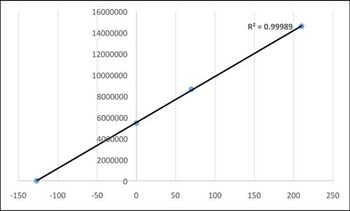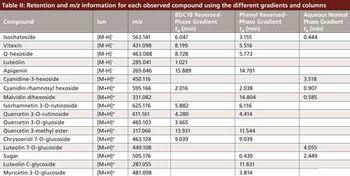
Special Issues
Click the title above to open the LCGC North America October 2016 Advances in Food and Beverage Analysis Supplement, Vol 34 No s10, in an interactive PDF format.

Special Issues
Click the title above to open the LCGC North America October 2016 Advances in Food and Beverage Analysis Supplement, Vol 34 No s10, in an interactive PDF format.

Special Issues
An automated method for determination of water in liquid sweeteners was developed utilizing headspace gas chromatography (GC) and ionic liquid-based capillary GC columns. This method allowed for the rapid determination of water with minimal sample pretreatment. In addition to providing fast analysis time for the samples, the headspace GC method was found to be accurate and precise for the measurement of water in 16 liquid sweeteners. This method was shown to be widely applicable for sugar and sugarless based sweeteners and likely, more accurate than Karl Fischer titration.

Special Issues
A method based on salting-out assisted liquid-liquid extraction for the analysis of α-dicarbonyls in wines was developed. The sample preparation procedure consists in a single step, involving the simultaneous extraction and derivatization of the analytes using an o-phenylenediamine–acetonitrile solution with NaCl as the salting-out agent. The obtained organic phase is collected and directly analyzed by liquid chromatography with spectrophotometric detection. The studied α-dicarbonyls were determined in eight wines.

Special Issues
As a result of the rapidly growing cannabis industry, many testing laboratories are looking for efficient, reliable, and cost-effective analytical methods to analyze chemical residues, such as pesticides, mycotoxins, solvent residues, terpenes, and heavy metals, as well as cannabinoid concentration in cannabis-infused edibles and beverages. In this article, QuEChERS (quick, easy, cheap, effective, rugged and safe), a sample preparation technique widely adopted in the food testing industry, is introduced to the discipline of forensic testing as a viable method for the extraction of pesticides and cannabinoids in various complex sample matrices. Comparison of the claimed amounts of cannabinoids versus the actual amounts as well as the pesticide residue levels in edible and beverage samples is discussed.

Special Issues
Using an LC–MS method in conjunction with two complementary types of chromatographic retention modes-reversed phase and aqueous normal phase-various compounds present in mesquite flour extracts were identified. Because of the diverse types of chemical constituents found in such natural product extracts, a single chromatographic mode may not be sufficient for a comprehensive characterization. However, the combination of reversed phase and aqueous normal phase LC can encompass a wide range of analyte polarity. This characterization of the composition of mesquite flour could be used in future studies elucidating the beneficial health effects of their consumption.

Special Issues
Speciation analysis of elemental contaminants in food and beverages has received much attention in recent years. Recent regulations limit inorganic arsenic, taking into account that arsenic toxicity is dependent on the species present. The analysis procedure thus needs to be able to differentiate inorganic from organic arsenic forms. LC-ICP-MS is commonly used for separation and detection of arsenic species, with the most widely used implementation being based on ion exchange and characterized by relatively long run times. Testing of increasing sample numbers means that analysis speed becomes a focal point for potential improvements. We developed a method based on ion interaction chromatography, allowing a reduction in run times to

Special Issues
The German Beer Purity Law of 1516 makes beer one of the best analyzed food products with the highest standards regarding quality, freshness, appearance, and flavor. According to this law, beer is allowed to contain hops, malt, yeast, and water as ingredients. Of course, beer also contains major B vitamins, bitter substances, and minerals and trace elements (such as Ca, Na, Mg, and Zn) that are important for human nutrition. However, undesirable substances such as pesticides and heavy metals (for instance Cd, Pb, Hg, Sb, and As) can be found as well, mostly as contaminants in brewing water and grains. In particular, the herbicide glyphosate has to be monitored carefully since it is discussed as a possible carcinogenic. The chromatography of glyphosate is challenging because of its high polarity. A well-established method including a derivatization step with 9-fluorenylmethyl chloroformate (FMOC) followed by LC–MS analysis is time-consuming and also susceptible to errors. A sample pretreatment without derivatization is desirable because it is faster and cheaper. A triple quadrupole mass spectrometer optimizes the analytical procedure and establishes a routine method for the analysis of glyphosate in beer. For the determination of low element concentrations, such as As, Se, Pb, Cd, and Zn, inductively coupled plasma-mass spectrometry (ICP-MS) is applied.